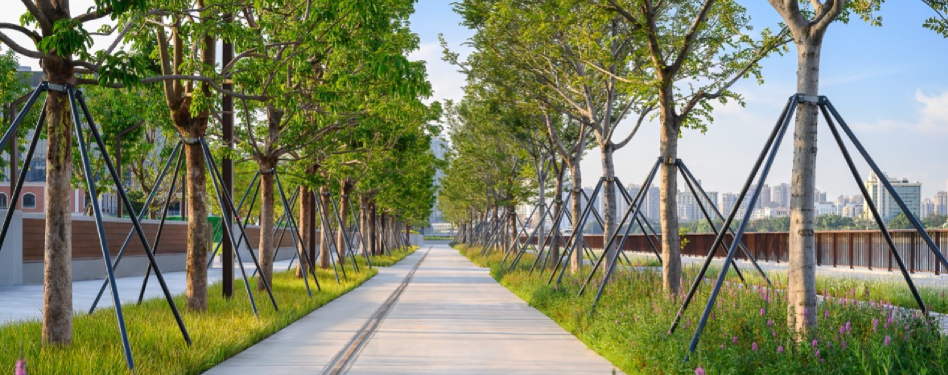
Feature image photo credit: Bai'etan.
The Bai’etan Exhibition Center in Guangdong is the first project to achieve SITES Platinum certification in China. This major urban regeneration project is nestled in the heart of China's thriving Great Bay area, one of the country's most densely populated regions, where modern industry and rapid urbanization have taken hold over the past few decades.

Photo credit: Bai'etan.
An aging warehouse and surrounding industrial park built in the 1970s were the starting point for the Exhibition Center’s 125,000-square-foot waterfront greenscape. Through environmentally friendly, community-driven, regenerative material and low-carbon strategies, the project aims to redefine sustainable landscape development for the region.
The Bai’etan team restored the site’s riverbank to create a rich ecological habitat for terrestrial and aquatic wildlife, including the region’s migratory waterfowl. The project features entirely native vegetation, selected for both beauty and improved biodiversity. Today, the area includes five times more vegetation than its original square footage, creating a much higher Biomass Density Index (BDI) due to improved canopy and ground coverage.
Within the context of an ever-evolving megacity, the project focused on preserving its cultural roots sustainably. Several large banyan trees preserved on the existing riverfront serve as proud symbols of Cantonese culture. Interactive maps help visitors connect to the landscape, explaining the efforts and significance behind elements of the project.

Photo credit: Bai'etan.
The team faithfully pursued “reduce, reuse, recycle” as its approach to material strategy. Reusing existing building components such as a flood control wall, bricks, wooden beams and concrete blocks, the project’s design strategy developed a new, functional landscape that maintains the integrity of the original space, saving an estimated $110,000 in the process.
In line with China’s “Sponge City Initiative” and the global push toward carbon neutrality, Bai’etan pursued sustainable energy and water reduction strategies where possible. Diverse functional stormwater features were installed to reduce river pollution and flooding, and to enhance potable water use. The total annual runoff control rate of the project has reached a very high standard, compared with other projects in China. With an estimated annual cost savings of over $8,000, this natural stormwater management sets a benchmark for municipal water treatment methods in Guangzhou. By combining low-carbon equipment with nature-based climate solutions, the site reduces at least 60% of its electric consumption and eliminates more than 100 tons of carbon emissions per year.
By using the SITES rating system to guide sustainable landscape development and carbon neutrality efforts, the Bai’etan Exhibition Center created a unique waterfront location that thoughtfully integrates biodiversity and cultural heritage.
“To date, five projects have been awarded SITES certification in China, and over 20 projects are undergoing the certification process,” explained Zihan Zhou, Specialist in Market Transformation and Development for the Sustainable Cities Program for GBCI China. “In addition to raising public awareness of sustainable landscapes, SITES serves as a tool to help project teams measure landscape performance and improve site value. In the future, we believe that more and more Chinese projects will join the SITES rating system to jointly build the sustainable development of the urban ecosystem.”
